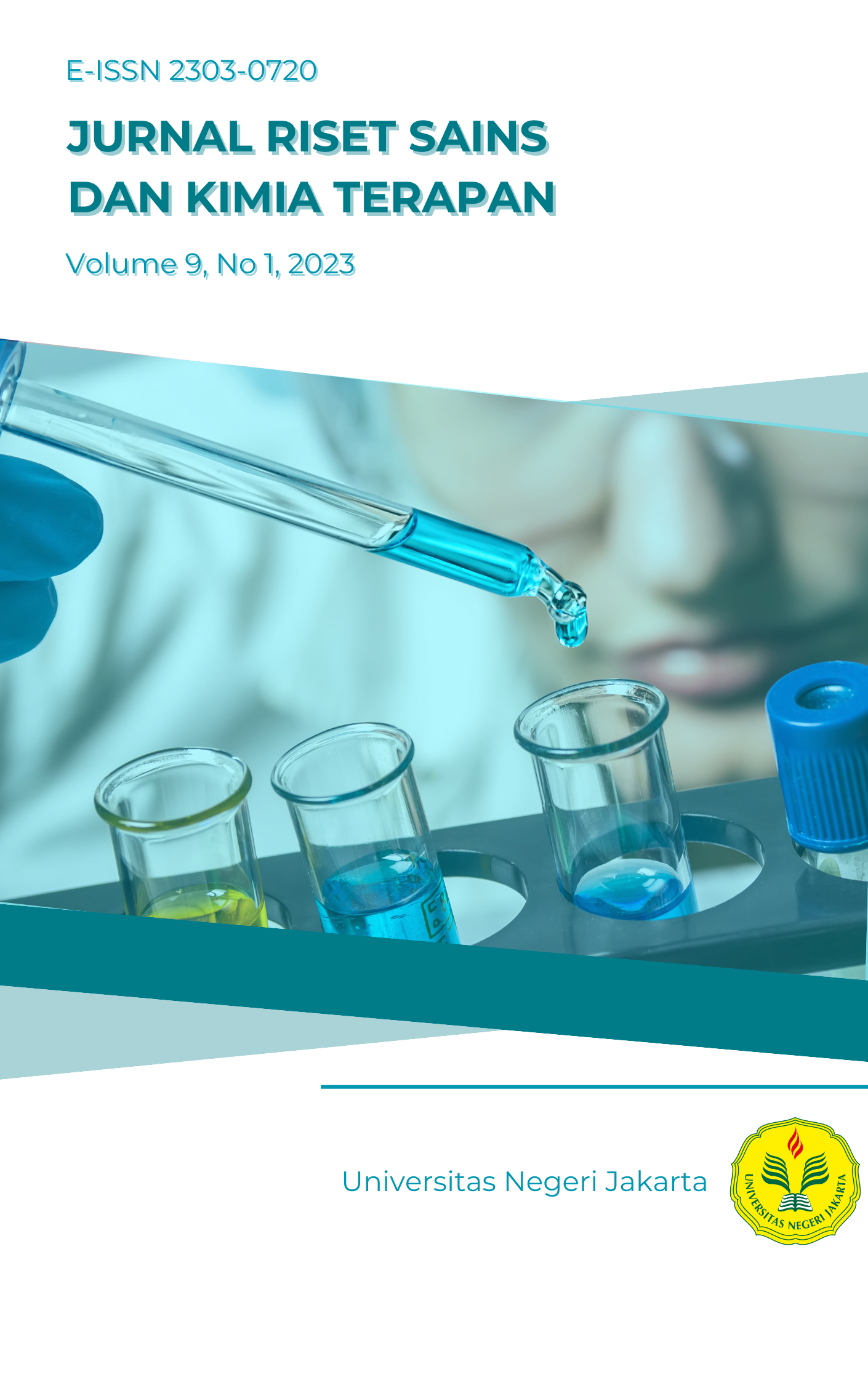Validasi Metode Analisis Kandungan Nitrogen Dioksida di Lingkungan Kerja menggunakan Metode Griess-Saltzman
DOI:
https://doi.org/10.21009/JRSKT.101.05Keywords:
lingkungan kerja, metode griess-saltzman, nitrogen dioksidaAbstract
Abstrak
Nitrogen dioksida merupakan adalah gas beracun yang dihasilkan terutama sebagai produk sampingan dari proses pembakaran seperti mesin mobil, pembangkit listrik, dan asap rokok. Gas NO2 dapat menyebabkan berbagai penyakit pernafasan akut. Karne NO2 termasuk polutan berbahaya, maka dibutuhkan pemantauan pada NO2 untuk membuat lingkungan lebih aman dan bersih. Dalam pemantauan konsentrasi NO2 di udara ambien terdapat suatu metode yang telah ditetapkan dalam SNI:7119-2:2017. Metode tersebut diperlukan diuji kembali agar sesuai dengan ketentuan dalam pengujian kadar NO2 di lingkungan kerja yang memiliki nilai ambang batas yang berbeda dengan udara ambien. Untuk mencapai hal tersebut harus dilakukan validasi metode sebagai pemenuhan syarat bahwa metode dapat diaplikasikan dalam analisa. Validasi metode tersebut dilakukan penentuan linearitas, batas deteksi dan batas kuantifikasi, uji presisi dan akurasi metode, ketahanan dan ketangguhan metode uji, dan estimasi ketidakpastian pengukuran. Hasil menunjukkan bahwa dari seluruh parameter uji telah memenuhi syarat keberterimaan.
Kata kunci: lingkungan kerja, metode griess-saltzman, nitrogen dioksida
Abstract
Nitrogen dioxide is a toxic gas produced mainly as a by-product of combustion processes such as automobile engines, power plants, and cigarette smoke. NO2 gas can cause various acute respiratory diseases. Since NO2 is a hazardous pollutant, it is necessary to monitor NO2 to make the environment safer and cleaner. In monitoring the concentration of NO2 in ambient air, there is a method that has been established in SNI: 7119-2: 2017. The method needs to be tested again so that it is in accordance with the provisions in testing NO2 levels in the work environment which has a different threshold value from ambient air. To achieve this, method validation must be carried out as a fulfillment of the requirement that the method can be applied in analysis. The validation of the method is carried out by determining linearity, detection limit and limit of quantification, precision and accuracy test of the method, durability and robustness of the test method, and estimation of measurement uncertainty. The results show that all test parameters have met the acceptance requirements.
Keywords: griess-saltzman method, nitrogen dioxide, work environment
References
Cerrato-Alvarez, M., Frutos-Puerto, S., Arroyo, P., Miró-Rodríguez, C., & Pinilla-Gil, E. (2021). A portable, low-cost, smartphone assisted methodology for on-site measurement of NO2 levels in ambient air by selective chemical reactivity and digital image analysis. Sensors and Actuators B: Chemical, 338, 129867–129867. https://doi.org/10.1016/j.snb.2021.129867
Chang, J., Xu, Y.-F., Xiao, J., Wang, L., Jiang, J.-Q., & Guo, J.-X. (2023). Influence of acid rain climate environment on deterioration of shear strength parameters of natural residual expansive soil. Transportation Geotechnics, 42, 101017. https://doi.org/10.1016/j.trgeo.2023.101017
Dailah, H. G. (2022). Therapeutic Potential of Small Molecules Targeting Oxidative Stress in the Treatment of Chronic Obstructive Pulmonary Disease (COPD): A Comprehensive Review. Molecules, 27(17), 5542. https://doi.org/10.3390/molecules27175542
Fatima, F. (2021). A review on acid rain: An environmental threat. Pure and Applied Biology, 10(1). https://doi.org/10.19045/bspab.2021.100032
Hambir, S., & Jagtap, S. (2023). Nitrogen dioxide gas-sensing properties of hydrothermally synthesized WO3 NH2O nanostructures. Royal Society Open Science, 10(4). https://doi.org/10.1098/rsos.221135
Liu, Z., Shi, Z., Wei, H., & Zhang, J. (2022). Acid rain reduces soil CO2 emission and promotes soil organic carbon accumulation in association with decreasing the biomass and biological activity of ecosystems: A meta-analysis. CATENA, 208, 105714. https://doi.org/10.1016/j.catena.2021.105714
Niepsch, D., Clarke, L. J., Tzoulas, K., & Cavan, G. (2022). Spatiotemporal variability of nitrogen dioxide (NO2) pollution in Manchester (UK) city centre (2017–2018) using a fine spatial scale single-NOx diffusion tube network. Environmental Geochemistry and Health, 44(11). https://doi.org/10.1007/s10653-021-01149-w
Perez-Lauterbach, D., Nahum, R., Ahmad, H., Topeff, J. M., Dossick, D., Cole, J. B., & Arens, A. M. (2019). Dose-Dependent Pulmonary Injury Following Nitrogen Dioxide Inhalation From KinepakTM Detonation. the Journal of Emergency Medicine (S.l. Online), 57(2), 177–180. https://doi.org/10.1016/j.jemermed.2019.03.028
Prakash, J., Agrawal, S. B., & Agrawal, M. (2022). Global Trends of Acidity in Rainfall and Its Impact on Plants and Soil. Journal of Soil Science and Plant Nutrition, 23(1). https://doi.org/10.1007/s42729-022-01051-z
Shah, V., Jacob, D. J., Dang, R., Lamsal, L. N., Strode, S. A., Steenrod, S. D., Boersma, K. F., Eastham, S. D., Fritz, T. M., Thompson, C., Peischl, J., Bourgeois, I., Pollack, I. B., Nault, B. A., Cohen, R. C., Campuzano-Jost, P., Jimenez, J. L., Andersen, S. T., Carpenter, L. J., & Sherwen, T. (2023). Nitrogen oxides in the free troposphere: implications for tropospheric oxidants and the interpretation of satellite NO2 measurements. Atmospheric Chemistry and Physics, 23(2), 1227–1257. https://doi.org/10.5194/acp-23-1227-2023
Suganthi, K., Vinoth, E., Sudha, L., Bharathi, P., & Navaneethan, M. (2023). Manganese (Mn2+) doped hexagonal prismatic zinc oxide (ZnO) nanostructures for chemiresistive NO2 sensor. Sensors and Actuators B-Chemical, 380, 133293–133293. https://doi.org/10.1016/j.snb.2023.133293
Tian, Y., Zhang, X., Shen, H., Liu, A., Zhao, Z., Chen, M.-L., & Chen, X.-W. (2017). High Time-Resolution Optical Sensor for Monitoring Atmospheric Nitrogen Dioxide. Analytical Chemistry, 89(24), 13064–13068. https://doi.org/10.1021/acs.analchem.7b03578
Wenzel, J., Schmidt, F., Blumrich, M., Amberg, A., & Czich, A. (2022). Predicting DNA-Reactivity of N-Nitrosamines: A Quantum Chemical Approach. Chemical Research in Toxicology, 35(11), 2068–2084. https://doi.org/10.1021/acs.chemrestox.2c00217
Yang, Y., Wang, J., Zhang, Z., & Lin, G. (2023). Study on the concentration retrieval of SO2 and NO2 in mixed gases based on the improved DOAS method. RSC Advances, 13(28), 19149–19157.
Zhang, Y. Q., Luo, A., Chen, S. R., Ju, X., Chen, X. Y., Zhang, W. J., & Hao, Y. T. (2023). Causal links between long-term exposure to NO2 and the risk of cardiovascular hospitalization. PubMed, 44(6), 885–890. https://doi.org/10.3760/cma.j.cn112338-20221122-00989







